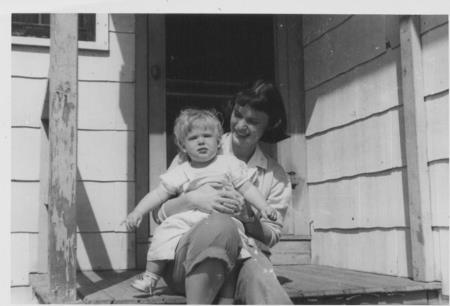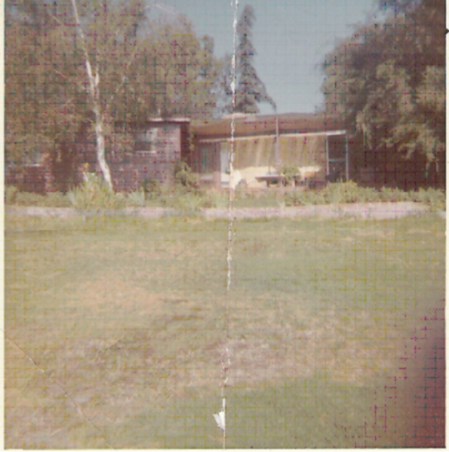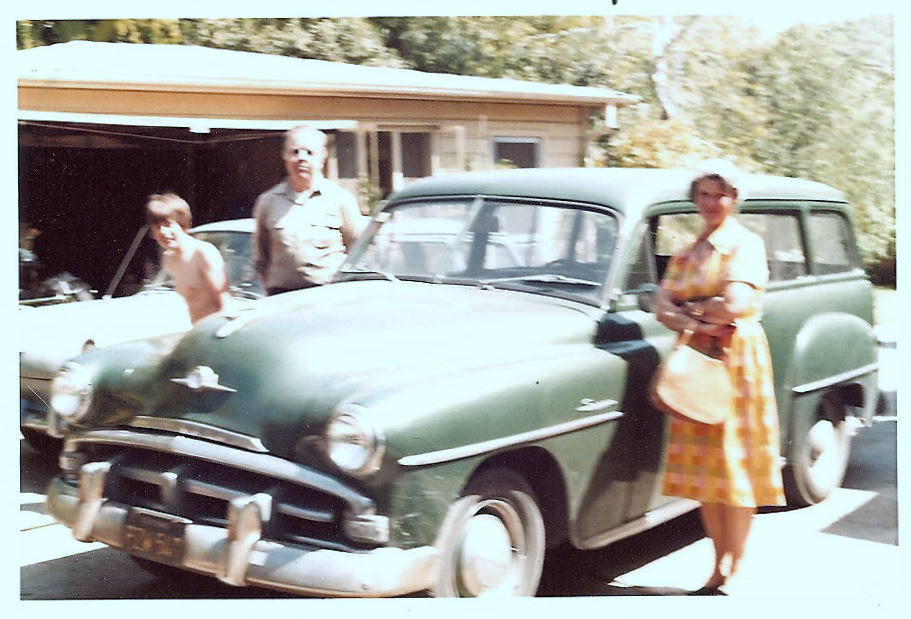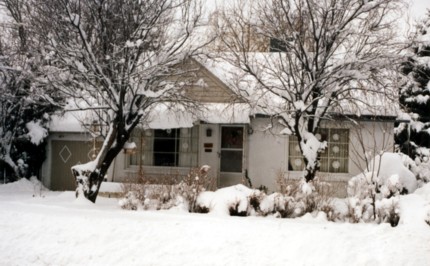Well, you can, sort of – but in the larger sense Thomas Wolfe was right: you can’t physically go home again, not after a good few years have passed. I’ve amused myself, since discovering google earth and street view by looking for and locating the houses that I have lived in, and seeing how they appear now. That is if I have a clear memory of the address, and if the house itself still exists. Which is not always the case: the GI student housing in Santa Barbara was gone shortly after Dad finished the graduate level program at UC-Santa Barbara in the mid-1950ies. I have no notion of where to even begin looking for the house in the backwoods of Beverly Hills (yes, Beverly Hills does, or did have a backwoods, per se.) With unpaved roads, even, although it probably isn’t the case now. The White Cottage at the corner of La Tuna Canyon and Wheatland in the Sun Valley end of the San Fernando Valley is still there, although it looks as if the massive sycamore tree that shaded half of the back yard is gone, and La Tuna Canyon road has been widened and had sidewalks installed, so the fence line has been moved back. I can “walk” up the half-mile of La Tuna Canyon to Vinedale Elementary. The shapes of the hills looming over the canyon, as it funnels back into the Verdugo Hills are still familiar. Many of the roads which ran back from La Tuna Canyon were unpaved then – they’re paved now, it seems.

The next house, which I always thought of as Redwood house, was at the corner of Hillrose and Rosetta, at that corner of Shadow Hills which touched the edge of Sunland. Again, a dirt road, and lines of olive trees which had once been part of an olive orchard. That house is long gone – it was where the 210 Freeway drops down into Big Tujunga Wash, halfway between the Ralphs’ on Foothill Boulevard, and the fire station on Wentworth. I can “walk” from Sunland Elementary to Olive Grove and up a block to Hillrose … and that’s where the road ends, at a chain-link fence overlooking the highway.

The house after that, the second house on the left up Cedarvale from Estepa, was curiously only a stone’s throw from the White Cottage, geographically. Not by road, though – it was a drive of at least half an hour between the two, going around through two different canyons. It’s been remodeled, extensively from when we lived there, and the new owners cut down most of the trees around the house. We liked the trees for the shade, but now the view is spectacular, or so I can judge from street view. The pool is still there, but I can’t see if the well still exists. There was a small spring/seep in the hillside, and a small well which never dried out entirely. I lived there from the age of sixteen, until I enlisted in the Air Force. My parents sold that house when my youngest brother finished high school and decamped to Northern San Diego County.

I think the barracks where I lived at Misawa AB is gone; that whole base was revamped when the F-16 wing moved in. I can’t even begin to find building in the R housing area, out the POL gate where I rented the little sliver of apartment. That whole area has been revamped. The Wherry duplex in the enlisted housing area at Mather AFB where we lived for a year – that’s all gone. It looks like all very upscale condos, now. That was a very bare-bones kind of place; conblock walls, industrial linoleum on the floor, and metal cabinets in the kitchen. I had no furniture other than a rattan rocking chair, a couple of book cases, and my daughter’s crib when we moved in, but by the time we moved on, I had managed to purchase a single arm chair, an upholstered small sofa, a round wooden table and two chairs. There was a trailing rose bush by the front door. The housing office inspector gave me grief for trying to train it up the porch supports. This experience and the chore of cleaning that place before checking out of that base cured me of any desire to live in base housing. Uncle Sam is a sucky landlord.
The barracks at Sondrestrom AB in Greenland is still there; they’ve jazzed up the grey concrete slabs with red and white stripes, and green paint, and put a modernistic entryway to what was the dining facility; not much has changed with all that, at least on the surface. Looks like there are some restaurants, and a B&B, but the general aspect is still gritty grey dust, and bare rock mountains looming above. As we used to say grimly to each other: it’s not the end of the world, but you can see it from there. In the winter – when it was midnight-dark for most of the day with perhaps a pale twilight at mid-day, it was an amazing and unearthly sight; to come down the hill from the AFRTS station, and see the whole base lit by glowing yellow lights. In the dry arctic air, the vents from the buildings filled the head of the fjord with billowing golden clouds of water vapor.
For three years after that, we lived in a second-floor apartment on a corner in suburban Athens; a narrow balcony ran around two sides of the apartment, which took up the whole of a single floor, at the intersection of Knossou and Delphon. From the windows on the street side, we could look out at the Saronic Gulf and the perfect triangular island of Aegina; it looks like they have built another three or four story apartment block across the street, so likely there is no chance of that same view from the apartment today. The little tile-roofed villa across the road in the other direction is still there, but the empty lot which was next door, in which an elderly man kept chickens and rabbits and a bit of a garden with lemon trees, has been replaced by another three or four story apartment block. But the building itself looks well-kept; whoever is living in the second-floor apartment has a series of nice plants in pots along the balcony.
Spain: the place where we lived the longest until we settled in Texas. I had no taste for a high-rise city apartment, which was all that was on offer, until the friend who was helping me house hunt said, “Let’s go see if there’s anything in San Lamberto…” This was a complex of duplexes and low-rise apartment buildings outside the city, which once had been American base housing, but now was in private ownership. There was an empty unit available for a reasonable rent, at the corner of what is now Calle Placido Domingo and Calle C. A ground-floor unit with a garden, and a shaded terrace. It is barely recognizable, now, although the two palm trees are still there and thriving. The new owners added a swimming pool, a small addition where I used to stack wood for the fireplace outside the dining area window, and a covered shelter for a car. The low wall and pillars are still there, but they have put in dark green fencing panels above, and the lawn looks a little better than when I lived there. My daughter went from kindergarten to the sixth grade in the time we lived there. I tried tracing the route that I usually drove from San Lam, past the Spanish regional airport to the Garripinellos gate, but again – too much has been changed. It used to be a narrow wandering country road; now there’s some fairly substantial interchanges.
The little white and grey house in the middle of the block of Jefferson between 36th and 37th was the perfect small house. I wish I could have owned it, so that I could have fixed it up properly. A perfect dolls’ house, with a big window on either side of the front door, and a long garden in back, with hedges so thick on either side that the lights of other houses could barely be seen in summer. Lilacs along one side, a row of apricot trees on the other, a bearing cherry tree, a shed where we might have kept chickens, a green lawn and a garden plot which I managed to rototill for two summers. In the spring, lilies of the valley came up at the edge of the front walk … we were there for two and a half years. The sun came up in the morning over the iron-grey wall of the Wasatch front, and in the afternoon, light poured in through the back of the house through an enormous picture window which gave on the yard. Paradise. I am still angry at the assignment detailer for my career field, who did not send me back there; this after hearing for years how they would reward you for years overseas by making certain that your last assignment before retiring was to the base where you most wanted to be. The house looks good, though: the present owner has taken down that cheap metal awning over the porch, and put in a planter and a new set of steps where the front porch used to be, and taken out the ragged hedge which formerly bisected the lawn.

Korea: a year in a barracks building, across the road from the Navy Club at Yongsan Army Infantry Garrison. It looks as if that building isn’t there, as far as I can see. The whole garrison has relocated to Camp Humpreys, but the Dragon Hill Lodge still exists, as a recreation center and hotel run by MWR. No luck in tracing anything of my route to work at AFKN, on the hill above the main PX.
The one home that I most deeply regret loosing was not a home which I lived, although my daughter did, during the year that I spent in Korea; that was Mom and Dad’s retirement place, the house that Dad first designed and oversaw building on a rocky knoll with a view down into the Guajito, in the hills above Valley Center, Northern San Diego County. They spent five years doing this, having initially expected to get it done in three, but had a marvelous time anyway. When we came home between tours in Spain (having saved the government a bomb of money through signing on to a second tour in place, so we had a free round-trip home as a reward) the house was coming down the home stretch, and we shared the RV with Mom, Dad, and their dogs. It was far enough along that we celebrated Christmas in the house, among the sheets of drywall stacked up in the dining are – drywall which Dad would teach me to hang and mud. Mom designed and laid out the garden – and when the house burned in the Paradise Mountain Fire in 2003, Mom and Dad moved into another RV on the site and built it all again, with improvements. (They hired out all the tough jobs that Dad had done, first time around.) We made a road trip from Texas to California most years. And then Dad died, suddenly in 2010. Mom didn’t want to leave the place they had shared, although … we all worried about her being there alone with the dogs. My youngest brother even brought up how risky it was, only to be slapped down. A few years later, his fears were realized when Mom fell and injured her back so severely that she was paralyzed from the shoulders down. Their house had to be sold, of course. My sister, who took over care of Mom, needed to have her own house renovated to accommodate a semi-paralyzed invalid. Originally, we were all four supposed to inherit a quarter share of it, and I entertained thoughts of buying out my brothers’ and keeping the property as a kind of family compound. Not to happen. I used the proceeds from the sale of my own California real estate to fix up the current Chez Hayes. Likely, I will never return to California. But I look at the view from the dead-end road past Mom and Dad’s house, and follow the dirt road back, looking at all the places that we went past, and think of the view over the Guajito, of how I would run on the dirt roads in the early morning, and the quail pattering through the thicket by the gate because Dad was in the habit of throwing out seed for them, the bends in the Woods Valley Road, the stench from the chicken farm at the foot of the last leg of road up to Mom and Dad’s…
It doesn’t look like the new owners have done very much, at least, not that we can see from the road view. But the owners of the next property over seemed to have established a nursery; greenhouses, and sheds and all. The previous owner of that place had let it go to wrack and ruin; basically returning to nature after the fire, save for messing around incompetently with an earth-mover on weekends – to the detriment of the watershed down into Mom and Dad’s driveway.
My daughter looked at the satellite view, and said, “Don’t say anything of this to Mom.”
No, you can’t go home.

Recent Comments